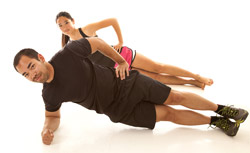Health Blog
Prehabilitation improves physical function for hip and knee arthritis

For some osteoarthritis patients, waiting too long for surgery may make matters worse.
Osteoarthritis (OA) is the wearing away of cartilage in joints
that leads to pain and reduced function. It is the most common
type of arthritis and it currently affects more than 20 million
Americans. Unfortunately, the cause of OA is not known and there
is no definitive cure for the disorder, but strategies to treat
it focus on reducing pain and improving function. When this type
of treatment is unsuccessful over time, total joint arthroplasty
(TJA), or replacement of the affected joint, is usually
recommended. Sadly, many patients in this predicament experience
long wait times before surgery can be performed, and during this
time the function of their hip or knee OA can get even worse. One
possible strategy to prevent this from occurring is to give these
patients prehabilitation, which is a program of exercise and
education to help maintain function. To evaluate this type of
program, a study was performed on patients with severe OA waiting
for TJA.
Patients are assessed and placed in three different
categories
A group of 650 patients with severe OA were evaluated by a
physical therapist and assigned to one of three categories:
Stream 1 (minimal need for surgical preparation), Stream 2
(moderate need) or Stream 3 (maximal need). From here, 28
patients with the greatest disability were selected from Streams
2 & 3 to participate in the supervised prehabilitation program.
Each program was specifically designed by a physical therapist
based on the individual needs of each patient, but the overall
goal of each program was to improve the function of the affected
joint through stretching, strengthening and range of motion
exercises. Most programs lasted about nine weeks, and all
patients were instructed to also exercise independently at least
once a day on their own and to continue taking any medications
prescribed for their OA.
Significant improvements observed in most measures taken
Patients were assessed once again after the conclusion of the
prehabilitation intervention. Results from these assessments were
positive, as they showed that the program led to significant
improvements in physical function for patients in the program.
This was seen in both self-reported function and in physical
performance measures, both of which showed statistically
significant improvements after the intervention. These outcomes
therefore support the use of prehabilitation for patients with
severe OA waiting for surgery that may otherwise lose function of
their affected joint. This may be due to the fact that these
programs were each tailored specifically to each patient with
their needs and abilities in mind. Furthermore, other evidence
shows that the better the physical function of a patient is
before going into surgery, the better their chances recovering
successfully. For these reasons, prehabilitation is recommended
as an effective strategy to improve function and reduce pain for
patients with severe hip or knee OA while awaiting TJA, and may
lead to a better outcome after surgery.
-Summarized by Greg Gargiulo -As reported in the Fall '13 edition of Physiotherapy Canada
February 4, 2014
Back to Health BlogHEALTH BLOG
- A Personalized Physical Therapy Program Can Assist with Whiplash
- Why Older Adults Should Incorporate an Exercise Program
- After an Achilles Injury, Physical Therapists Can Help with Recovery
- AI Can Answer Questions But It’s Best to See a Physical Therapist
- Physical Therapy Can Help With Symptoms of Wryneck
- Reduce the Risk of Pickleball Fractures By Taking Proper Precautions
- Physical Activity May Slow the Progression of Parkinson's Disease
- Too Much Salt in Your Diet? Learn the Dangers of High Sodium Intake
- Suffer From Lower Back Pain? Might Be Time to Take A Break
- The Road to Recovery: Preventing Re-Injury After ACL Surgery
RECENT ARTICLES

- 11 Possible Reasons Your Back HurtsJune 22, 2020

- What Conditions Can a Chiropractor Treat?May 25, 2020

- A Simple Guide to Better PostureApril 30, 2020

- Is Acupuncture Right for Me When I’m Afraid of Needles?March 30, 2020

- Stretching Done Right — How and When to StretchFebruary 26, 2020

